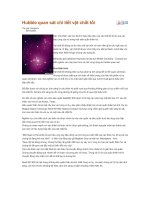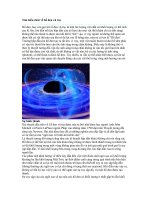Tài liệu SIFT: SCALE INVARIANT FEATURE TRANSFORM BY DAVID LOWE doc
Bạn đang xem bản rút gọn của tài liệu. Xem và tải ngay bản đầy đủ của tài liệu tại đây (846.39 KB, 39 trang )
SIFT: SCALE INVARIANT
FEATURE TRANSFORM BY
DAVID LOWE
Presented by: Jason Clemons
Overview
Motivation of Work
Overview of Algorithm
Scale Space and Difference of Gaussian
Keypoint Localization
Orientation Assignment
Descriptor Building
Application
Motivation
Image Matching
Correspondence Problem
Desirable Feature Characteristics
Scale Invariance
Rotation Invariance
Illumination invariance
Viewpoint invariance
Overview Of Algorithm
Construct Scale Space
Take Difference of
Gaussians
Locate DoG Extrema
Sub Pixel Locate
Potential Feature
Points
Build Keypoint
Descriptors
Assign Keypoints
Orientations
Filter Edge and Low
Contrast Responses
Go Play with Your
Features!!
Constructing Scale Space
Construct Scale Space
Take Difference of
Gaussians
Locate DoG Extrema
Sub Pixel Locate
Potential Feature
Points
Build Keypoint
Descriptors
Assign Keypoints
Orientations
Filter Edge and Low
Contrast Responses
Go Play with Your
Features!!
Scale Space
Constructing Scale Space
Gaussian kernel used to create scale space
Only possible scale space kernel (Lindberg „94)
where
Laplacian of Gaussians
LoG - σ
2
∆
2
G
Extrema Useful
Found to be stable features
Gives Excellent notion of scale
Calculation costly so instead….
Take DoG
Construct Scale Space
Take Difference of
Gaussians
Locate DoG Extrema
Sub Pixel Locate
Potential Feature
Points
Build Keypoint
Descriptors
Assign Keypoints
Orientations
Filter Edge and Low
Contrast Responses
Go Play with Your
Features!!
Difference of Gaussian
Approximation of Laplacian of Gaussians
DoG Pyramid
DoG Extrema
Construct Scale Space
Take Difference of
Gaussians
Locate DoG Extrema
Sub Pixel Locate
Potential Feature
Points
Build Keypoint
Descriptors
Assign Keypoints
Orientations
Filter Edge and Low
Contrast Responses
Go Play with Your
Features!!
Locate the Extrema of the DoG
Scan each DOG image
Look at all neighboring points
(including scale)
Identify Min and Max
26 Comparisons
Sub pixel Localization
Construct Scale Space
Take Difference of
Gaussians
Locate DoG Extrema
Sub Pixel Locate
Potential Feature
Points
Build Keypoint
Descriptors
Assign Keypoints
Orientations
Filter Edge and Low
Contrast Responses
Go Play with Your
Features!!
Sub-pixel Localization
3D Curve Fitting
Taylor Series Expansion
Differentiate and set to
0
to get location in terms
of (x,y,σ)
Filter Responses
Construct Scale Space
Take Difference of
Gaussians
Locate DoG Extrema
Sub Pixel Locate
Potential Feature
Points
Build Keypoint
Descriptors
Assign Keypoints
Orientations
Filter Edge and Low
Contrast Responses
Go Play with Your
Features!!
Filter Low Contrast Points
Low Contrast Points Filter
Use Scale Space value at previously found location
The House With Contrast Elimination
Edge Response Elimination
Peak has high response along edge, poor other
direction
Use Hessian
Eigenvalues Proportional to principle Curvatures
Use Trace and Determinant
Low Response
High Response
r
r
HDet
HTr
DDDHDetDDHTr
xyyyxxyyxx
22
2
)1(
)(
)(
)()(,)(
Results On The House
Apply Contrast Limit Apply Contrast and Edge Response
Elimination
Assign Keypoint Orientations
Construct Scale Space
Take Difference of
Gaussians
Locate DoG Extrema
Sub Pixel Locate
Potential Feature
Points
Build Keypoint
Descriptors
Assign Keypoints
Orientations
Filter Edge and Low
Contrast Responses
Go Play with Your
Features!!
Orientation Assignment
Compute Gradient for each blurred image
For region around keypoint
Create Histogram with 36 bins for orientation
Weight each point with Gaussian window of 1.5σ
Create keypoint for all peaks with value>=.8 max bin
Note that a parabola is fit to better locate each max (least
squares)
Build Keypoint Descriptors
Construct Scale Space
Take Difference of
Gaussians
Locate DoG Extrema
Sub Pixel Locate
Potential Feature
Points
Build Keypoint
Descriptors
Assign Keypoints
Orientations
Filter Edge and Low
Contrast Responses
Go Play with Your
Features!!
Building the Descriptor
Find the blurred image of closest scale
Sample the points around the keypoint
Rotate the gradients and coordinates by the
previously computer orientation
Separate the region in to sub regions
Create histogram for each sub region with 8 bins
Weight the samples with N(σ) = 1.5 Region width
Trilinear Interpolation (1-d factor) to place in histogram
bins
Building a Descriptor
Actual implementation uses 4x4 descriptors from 16x16
which leads to a 4x4x8=128 element vector









